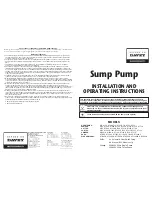
Series MNKA,
acc. to ASME
Page 14
9250-050-en
Revision 11
TM 7903
Edition 07/2010
6
Commissioning/Shutdown
6.1 Initial commissioning
Normally, the pumps have already been test-run with
water. Unless special agreements have been made,
there could still be residual amounts of water in the
pump. This must be noted in view of a possible
reaction with the medium.
Grease for life lubrication
The rolling bearings are greased for life.
Regreasing is not possible and not necessary.
For service lives, see
Section 7.2
.
Oil bath lubrication
Pour in oil into the bearing pedestal!
For procedure and the oil grade, see
Sections 7.2
and 7.8.5
6.1.1 Filling the pump housing (casing)
Check to see whether the screws on the suction
flange, discharge flange, housing (casing) flange
and drain flange are tightened. When retightening
the housing (casing) screws, make sure that the
support bracket is undone. Otherwise, the pump
could be deformed.
For screw tightening torques see
Section 1.1
.
Open the suction line fully so that the medium can
flow into the pump.
Open the discharge valve so that the air in the
pump can escape.
If air cannot be vented into the discharge line, e.g.
a drop in pressure in this line is not permitted,
venting must be performed upstream of the
discharge valve.
Monitor the venting operation until no air but only
liquid emerges.
Turn the pump shaft at the coupling several times.
Monitor the venting operation again until no more
air emerges.
Close the discharge valve again until
only the minimum flow rate is obtained
after the motor has been started.
6.1.2 Start-up
Check to see whether the pump shaft can be
readily turned by hand.
Check the direction of rotation of the
motor with the coupling disengaged or
with a rotary field instrument.
As viewed from the motor, the direction of rotation
of the pump is clockwise. See also the
direction of
rotation arrow
of the pump.
The pump must not run dry during the check
of the direction of rotation.
Engage coupling, check alignment and secure.
Mount coupling guard.
The pump must be completely filled with
liquid. The maximum admissible flow rate
must not be exceeded.
Otherwise the plain bearings can run dry in
both cases.
Switch the motor on.
Set the desired flow by opening the discharge
valve.
When the motor is running but the pump is not
conveying, this means that the magnetic drive
has stopped.
Switch the motor off immediately to prevent
overheating of the magnets.
Then proceed as follows:
Close discharge valve down to the position
"minimum flow rate".
Start motor again.
If the magnetic drive stops again, look for the cause.
Excessive power consumption may cause the
magnets to decouple. If this happens the
pump must be shutdown immediately and
cause corrected prior to restarting. Failure to do this
could result in demage to internal parts Failure to
follow this instructions may result in property damage,
sever personal injury, or death.
6.2 Operating limits
The operating limits of the pump/unit in terms
of pressure, temperature, power and speed
are entered in the data sheet and it is
imperative to observe them!
6.2.1 Abrasive media
If liquids with abrasive constituents are
conveyed, increased wear at the pump is to
be expected. The inspection intervals should
be reduced compared with the usual times.
6.2.2 Min./max. flow rate
The operating range generally recommended lies at
0.3 Q
opt
to 1.1 Q
opt
. Consult the manufacturer for
operation outside this range and observe
Section
2.6.2
.















































